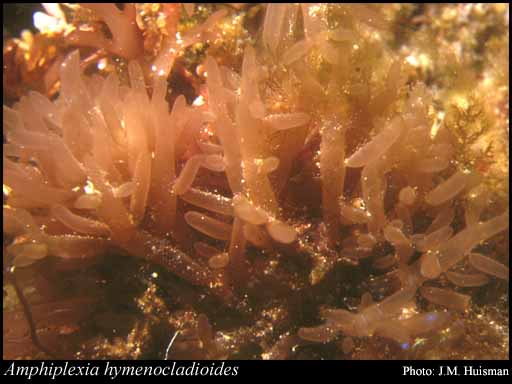- Reference
- Acta Univ.Lund. 28(6):111 (1892)
- Conservation Code
- Not threatened
- Naturalised Status
- Native to Western Australia
- Name Status
- Current

Scientific Description
Habit and structure. Thallus medium to dark red-brown, 5–15 cm high, with elongate-clavate segments (1–)2–5 cm long and 3–6 mm in diameter, with rounded apices and basally constricted, branching from near the apices and often from their upper half, developing a basal stalk 1–1.5 mm in diameter and up to 1 cm long. Holdfast crustose, knobby, 2–6 mm across, with one to a few fronds; epilithic. Structure multiaxial, developing a very lax filamentous, mucilage filled, medulla and a pseudoparenchymatous cortex with a single layer of large inner cells 25–50 µm across, L/D 1–2, and a small-celled outer cortex 1–2 cells thick, outer cells ovoid, 4–8 µm in diameter, in surface view forming rosettes around the margins of the large inner cells. Rhodoplasts laminate, 1–3 per outer cell.
Reproduction. Sexual thalli monoecious; procarpic. Carpogonial branches borne singly on inner cortical cells, 3-celled, directed inwards with reflexed trichogynes. Supporting cell becoming the auxiliary cell, with a short connection from the fertilized carpogonium; nutritive filaments developed from adjacent vegetative cells and partly surrounding the auxiliary cell, with prominent enveloping tissue developing from vegetative cells and enlarging to form a cavity. Gonimoblast initials developed thallus outwards, forming filaments which grow across the nutritive tissue and line the inner surface of the pericarp, then developing centripetally in branched clusters and forming rows of 2–3 ovoid carposporangia (terminally mature) 10–15 µm in diameter. Cystocarps protuberant, basally constricted, with enveloping tissue and outer thickened cortex, ostiolate. Spermatangial clusters scattered, formed on mid cortical cells, with 3–4 initials each bearing 3–5 elongate-ovoid spermatangia 2–3 µm in diameter. Tetrasporangia developed from mid cortical cells (often bearing 2 outer cortical cells and thus intercalary), basally pit-connected, ovoid, 20–40 µm long and 15–25 µm in diameter, zonately divided.
Distribution.Rottnest I., W. Aust., to Port Phillip Heads, Vic.
Habitat. A. hymenocladioides is a relatively rare alga, from shallow (probably shaded) situations to deep water.
[After Womersley, Mar. Benthic Fl. Southern Australia IIIA: 369–370 (1994)]
Distribution
- IMCRA Regions
- Abrolhos Islands, Central West Coast, Leeuwin-Naturaliste.
- Local Government Areas (LGAs)
- Cockburn, Coorow, Dandaragan, Greater Geraldton.